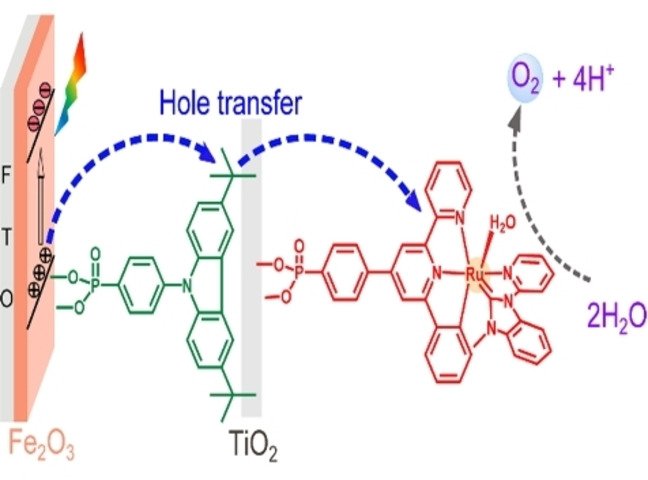 In fabricating an artificial photosynthesis (AP) electrode for water oxidation, we have devised a semiconductor-mediator-catalyst structure that mimics photosystem II (PSII). It is based on a surface layer of vertically grown nanorods of Fe2O3 on fluorine doped tin oxide (FTO) electrodes with a carbazole mediator base and a Ru(II) carbene complex on a nanolayer of TiO2 as a water oxidation co-catalyst. The resulting hybrid assembly, FTO|Fe2O3|−carbazole|TiO2|−Ru(carbene), demonstrates an enhanced photoelectrochemical (PEC) water oxidation performance compared to an electrode without the added carbaozle base with an increase in photocurrent density of 2.2-fold at 0.95 V vs. NHE and a negatively shifted onset potential of 500 mV. The enhanced PEC performance is attributable to carbazole mediator accelerated interfacial hole transfer from Fe2O3 to the Ru(II) carbene co-catalyst, with an improved effective surface area for the water oxidation reaction and reduced charge transfer resistance.
In fabricating an artificial photosynthesis (AP) electrode for water oxidation, we have devised a semiconductor-mediator-catalyst structure that mimics photosystem II (PSII). It is based on a surface layer of vertically grown nanorods of Fe2O3 on fluorine doped tin oxide (FTO) electrodes with a carbazole mediator base and a Ru(II) carbene complex on a nanolayer of TiO2 as a water oxidation co-catalyst. The resulting hybrid assembly, FTO|Fe2O3|−carbazole|TiO2|−Ru(carbene), demonstrates an enhanced photoelectrochemical (PEC) water oxidation performance compared to an electrode without the added carbaozle base with an increase in photocurrent density of 2.2-fold at 0.95 V vs. NHE and a negatively shifted onset potential of 500 mV. The enhanced PEC performance is attributable to carbazole mediator accelerated interfacial hole transfer from Fe2O3 to the Ru(II) carbene co-catalyst, with an improved effective surface area for the water oxidation reaction and reduced charge transfer resistance.
Niu, F.; Wang, D.; Williams, L. J.; Nayak, A.; Li, F.; Chen, X.; Troian-Gautier, L.; Huang, Q.; Liu, Y.; Brennaman, M. K.; Papanikolas, J. M.; Guo, L.; Shen, S.; Meyer, T. J. A Semiconductor-Mediator-Catalyst Artificial Photosynthetic System for Photoelectrochemical Water Oxidation. Chem. Eur. J. 2022, ASAP. https://doi.org/10.1002/chem.202102630